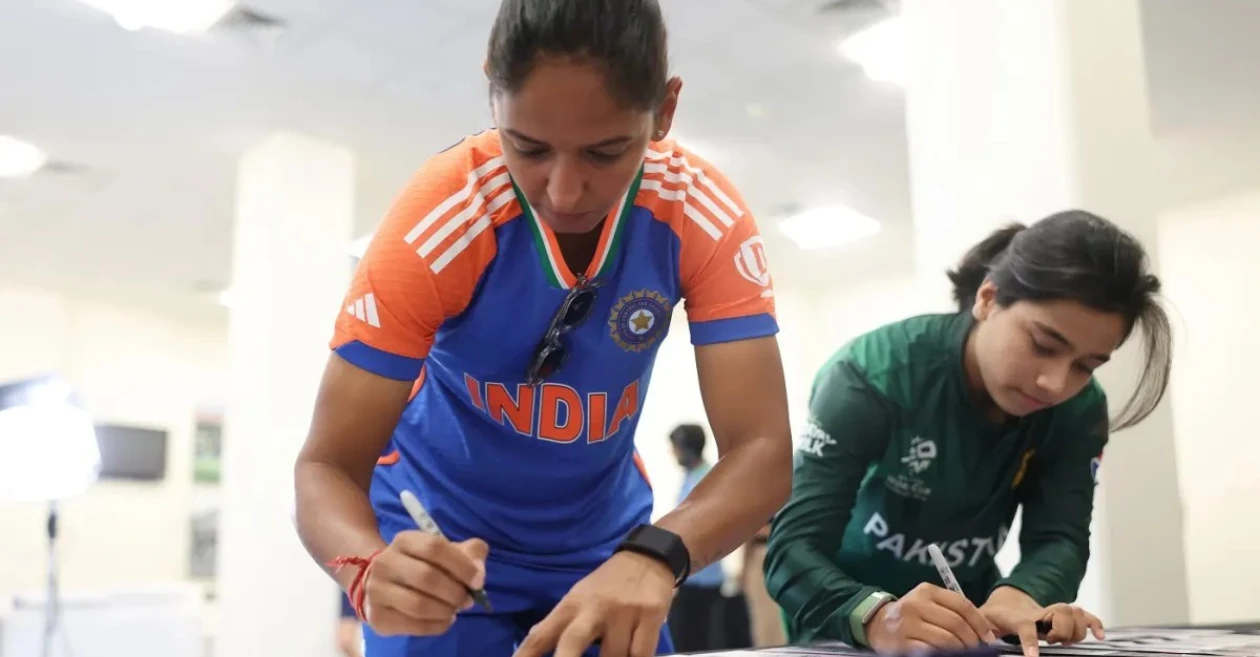The India vs Pakistan ICC Women’s World Cup 2025 clash in Colombo on October 5 is set to be one of the most anticipated matches in recent cricketing history. Traditionally, encounters between these two cricketing powerhouses have been high-voltage affairs, marked by intense competition and, often, cordial gestures of sportsmanship. However, the Board of Control for Cricket in India (BCCI) has now confirmed that there will be no handshakes, photo sessions, or other customary joint gestures for the upcoming women’s encounter, extending the precedent set by the men’s Asia Cup final earlier this year.
This decision has added a new dimension of intrigue and tension to what is already one of the most closely watched fixtures in international women’s cricket. While fans anticipate a thrilling contest on the field, the off-field narrative surrounding the match has taken center stage, intertwining politics, diplomacy, and cricket in a way that is uniquely characteristic of India-Pakistan encounters.
Background: Asia Cup 2025 and the Precedent
The backdrop to this announcement is crucial to understanding the BCCI’s stance. During the Asia Cup 2025 men’s final, the Indian team declined to shake hands with the Pakistani side and refrained from accepting the trophy from Pakistan Cricket Board (PCB) chief Mohsin Naqvi. The incident made headlines worldwide, highlighting how sporting protocols can intersect with geopolitical tensions.
Following this precedent, the BCCI has now formalized a similar approach for the women’s team. Secretary Devajit Saikia, while refraining from a direct answer on handshakes, emphasized that India’s diplomatic and sporting relationship with Pakistan remains unchanged and tense, signaling that the no-handshake policy is consistent with the broader political stance.
In practical terms, the women’s squad has been briefed on what to expect at the match in Colombo:
-
No handshake at the toss between captains.
-
No joint photo sessions with match referees or officials.
-
No end-of-match handshakes, regardless of the outcome.
While MCC cricketing protocols will still be adhered to, these traditional gestures of goodwill have been officially suspended for both men’s and women’s teams.
Political Context and Its Impact on Cricket
The BCCI’s decision cannot be viewed in isolation. It comes against a backdrop of escalating tensions between India and Pakistan, particularly following the Pahalgam terror attack and Operation Sindoor. These events have further strained bilateral relations, and the board’s policy aligns closely with the Indian government’s diplomatic stance, highlighting the intricate connection between politics and cricket in the subcontinent.
Historically, India-Pakistan cricket matches have often served as a soft diplomacy channel, where sportsmanship gestures like handshakes, trophy presentations, and joint photo sessions symbolized goodwill. The current policy, however, underscores how these opportunities for diplomacy have been curtailed, reflecting broader political sensitivities.
Cricketing analysts note that such decisions inevitably affect team morale and public perception. While the focus remains on the game itself, the symbolic absence of these traditional gestures can subtly influence how players, fans, and media interpret the contest.
Captain Harmanpreet Kaur’s Perspective
Amid the controversy, Indian captain Harmanpreet Kaur has opted for a pragmatic stance, emphasizing the importance of on-field performance over off-field theatrics. Speaking to the media ahead of the match, Kaur stated, “Our focus is entirely on our preparation, strategy, and execution. Cricket is our priority, and we will ensure our performance reflects that, irrespective of external factors.”
Kaur’s approach is reflective of a mature leadership strategy. By keeping the team’s attention on cricketing objectives rather than off-field controversies, she aims to maintain mental focus and cohesion, particularly crucial in high-pressure matches where external narratives can become distractions.
However, it is undeniable that the absence of traditional gestures creates a different atmosphere compared to previous encounters. The 2022 ODI World Cup in New Zealand, for instance, saw both sides engaging in warm interactions, reflecting camaraderie even amid competition. The current match, by contrast, will carry a heightened sense of formality and intensity, adding psychological layers to an already competitive contest.
The Women’s World Cup Context
The India vs Pakistan women’s clash is not just a bilateral contest; it is a pivotal World Cup fixture. Both teams are looking to consolidate positions in the early stages of the ICC Women’s ODI World Cup 2025, which has been co-hosted across multiple South Asian venues, including Colombo.
India’s Form and Key Players
India enters the match with strong recent form, having secured victories in bilateral series and performed well in warm-up matches. Key players likely to influence the match include:
-
Harmanpreet Kaur (c): India’s talismanic captain known for explosive batting and strategic acumen.
-
Smriti Mandhana: A technically sound top-order batter capable of anchoring innings or accelerating when required.
-
Deepti Sharma: Offers balance with all-round capabilities, combining spin bowling with aggressive batting.
-
Harleen Deol: Emerging as a power-hitter in ODIs, capable of changing games in the middle overs.
Pakistan’s Squad and Strategy
Pakistan, despite recent inconsistencies, will rely on experienced performers such as:
-
Bismah Maroof (vc): Experienced leader in the middle order.
-
Nida Dar: All-rounder providing depth in batting and crucial overs with the ball.
-
Aimen Anwar: Young talent capable of making an impact with aggressive stroke play.
-
Nashra Sandhu: Key spinner expected to control middle overs and apply pressure.
With high stakes and the added tension of a no-handshake policy, the match is poised to test both teams’ mental fortitude, focus, and adaptability.
High-Voltage Atmosphere on and off the Field
The absence of customary handshakes and joint photo sessions will likely heighten the intensity of the encounter. Analysts suggest several implications:
-
Psychological Edge: The lack of pre- and post-match gestures may add subtle psychological pressure on players, testing their composure under scrutiny.
-
Media Focus: With political and diplomatic undertones, the media narrative will extend beyond cricketing tactics to include commentary on team conduct and adherence to the policy.
-
Fan Engagement: While fans remain eager to witness cricketing excellence, the absence of traditional rituals may affect the match’s visual narrative, shifting attention from camaraderie to competition.
Interestingly, this scenario also presents an opportunity for players to channel focus entirely on cricket, potentially producing high-quality performances devoid of distractions. The absence of ceremonial routines allows both teams to prioritize execution, strategy, and skill application, a subtle but impactful advantage for players who thrive under pressure.
India-Pakistan Cricket Rivalry: Evolution and Challenges
The India-Pakistan cricket rivalry is one of the most storied in sports history. From historic Test series to World Cup clashes, every encounter has drawn millions of viewers worldwide, with expectations often exceeding the sporting context itself.
Historically, matches between the two nations have combined:
-
Competitive intensity: High-pressure performances from top players.
-
Sportsmanship gestures: Handshakes, trophy presentations, and joint photos symbolizing goodwill.
-
Diplomatic undercurrents: Informal engagement often reflecting wider geopolitical relationships.
The current policy, however, removes a layer of ceremonial goodwill, reflecting heightened political sensitivities and demonstrating how off-field events increasingly shape cricketing protocols. While fans will still witness the on-field contest, the atmosphere will carry a subtle undertone of tension and formality, marking a departure from past encounters characterized by warmth and sportsmanship.
Anticipated Match Dynamics
On the field, the contest promises to be highly competitive, with both sides eager to assert dominance in the tournament:
-
Pitch and Conditions: Colombo typically offers balanced conditions with a slight seam movement early and predictable bounce, favoring batters in the middle overs. Spinners will find grip later in the innings, making middle overs crucial for both teams.
-
Tactical Approaches: India may focus on aggressive powerplay scoring, leveraging Mandhana and Deol to set the tone. Pakistan, in turn, will look for disciplined bowling in the initial overs to contain India’s top-order assault.
-
Player Battles: Key individual battles, such as Kaur vs Nashra Sandhu and Mandhana vs Sidra Nawaz, will likely determine the match’s momentum.
With the no-handshake policy officially in place, these battles acquire an added dimension of seriousness. Every run, wicket, and tactical decision may carry more psychological weight than usual, reflecting the unique pressure environment of India-Pakistan encounters.
Broader Implications for Women’s Cricket
This development also signals a larger trend in women’s cricket, where matches are increasingly intertwined with political, diplomatic, and cultural contexts. The visibility of women’s cricket has risen dramatically, and high-profile matches between India and Pakistan now attract global attention comparable to men’s fixtures.
The no-handshake policy underscores several key points for the sport:
-
Professionalism and Focus: Women’s teams are being prepared to handle high-pressure scenarios with maturity and focus, irrespective of external distractions.
-
Media Scrutiny: Women’s cricket now operates under intense global scrutiny, highlighting the need for mental resilience and strategic preparation.
-
Role of Governance: Cricket boards, such as the BCCI, play a central role in setting protocols and policies that reflect broader national considerations while balancing sporting integrity.
This intersection of politics and sport adds layers to the match, elevating it beyond a simple contest into a symbolic and strategic sporting event watched worldwide.
As the India and Pakistan women’s teams prepare to face each other in Colombo, the ICC Women’s World Cup 2025 clash promises high-octane cricket under uniquely tense circumstances. The BCCI’s confirmation of no handshakes, no photo sessions, and no end-of-match gestures adds a new layer of formality and intensity, reflecting ongoing political realities.
While off-field protocols may dominate headlines, the true story will unfold on the pitch. Harmanpreet Kaur and her squad will aim to deliver a commanding performance, showcasing skill, strategy, and mental toughness. Pakistan, too, will be motivated to challenge one of the strongest teams in women’s cricket, proving their mettle under scrutiny.
Ultimately, this match is set to be remembered not only for runs, wickets, and tactics but also for its off-field symbolism, representing how cricket continues to intersect with politics and diplomacy in the subcontinent. Fans worldwide will be watching keenly, appreciating the skill and resilience of women cricketers navigating a contest shaped by history, rivalry, and the demands of international sport.
While traditional gestures of sportsmanship are absent, the competitive spirit, talent, and determination on display will define the match, reminding the cricketing world that on-field excellence transcends ceremonial protocols. For India and Pakistan, October 5 in Colombo will be a test not just of cricketing ability, but of focus, composure, and the enduring passion that defines one of sport’s most iconic rivalries.
Please check for information on the best betting sites in India – https://selectory.org/best-betting-sites/















